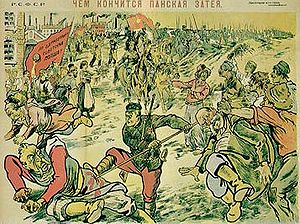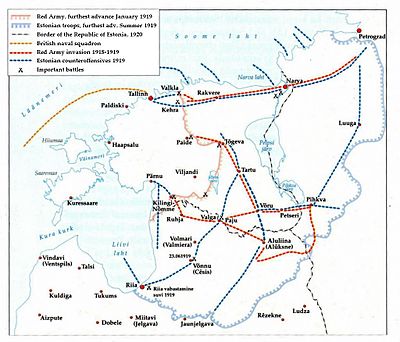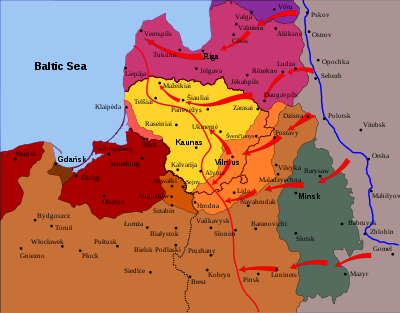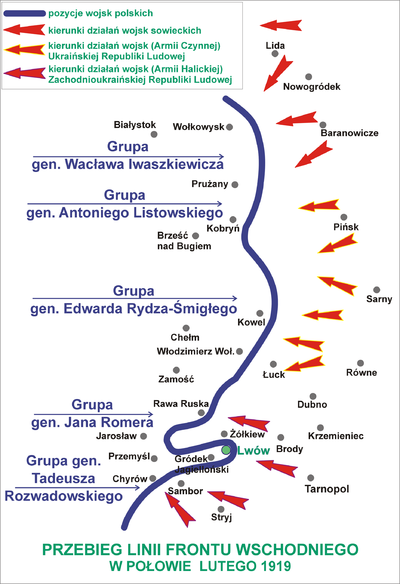- Soviet westward offensive of 1918–1919
-
Soviet westward offensives of 1918–1919 Part of Russian Civil War, Polish-Soviet War, Estonian War of Independence, Latvian War of Independence, Lithuanian Wars of Independence, and Ukrainian War of Independence 
Soviet propaganda poster : Defeat of White PolandDate November 18, 1918 – March, 1919 Location Belarus, Estonia, Latvia, Lithuania,
Poland, Russia, UkraineResult Soviet defeat Belligerents  Belarus
Belarus
 Estonia
Estonia
 Latvia
Latvia
 Lithuania
Lithuania
 Poland
Poland
 White Movement
White Movement
 Ukraine
Ukraine
 United Kingdom
United Kingdom
 Ober Ost
Ober Ost
Finnish volunteers Russian SFSR
Russian SFSRCommanders and leaders  Johan Laidoner
Johan Laidoner
 Józef Piłsudski
Józef Piłsudski
 Max Hoffmann
Max Hoffmann Jukums Vācietis
Jukums Vācietis
 Dmitrij Nadëžnyj
Dmitrij NadëžnyjStrength Estonia: 19,000[1]
Poland: ?285,000 The Soviet westward offensive of 1918–1919 was part of the general move of the Russian Soviet Federated Socialist Republic into the areas abandoned by the Ober-Ost garrisons, that were being withdrawn to Germany following that country's defeat in the World War I. The Soviet Western Front offensive against the Republic of Estonia ended in stagnation on the borders of the state. The offensive in the Vistula river direction by the newly created Western Army had the aim of establishing Soviet governments in Belarus, Ukraine and Poland and to drive as far west as possible and possibly join up with the German Revolution. The campaign eventually led to the Estonian Pskov Offensive, the White Russian Petrograd Offensives, and the Polish-Soviet War.
The best known comprehensive historical analysis of the campaign against Poland was performed by Norman Davies in his book White Eagle, Red Star (1972). Davies mentioned the codename for this offensive: Target Vistula; however, it is not commonly used in historiography.[2]
Contents
Before the battle
After signing the Treaty of Brest-Litovsk, Bolshevik Russia lost the European lands it annexed in the 18th century and 19th century. Most of today's Poland, Belarus, Ukraine and the Baltic States was passed to the government of Germany, which in turn decided to grant these states limited independence as buffer states. However, the German defeat on the Western Front and internal dissolution of Austria-Hungary, made the plans for creation of Mitteleuropa obsolete.
The German army started a retreat westwards. Demoralised officers and revolting soldiers abandoned their garrisons en masse and returned home. The areas abandoned by the Central Powers became a field of conflict between the local governments created by Germany as part of their plans, local governments that sprung up after the withdrawal of the Germans and the Bolsheviks that wanted those areas to be incorporated to the Bolshevik Russia. Nor were Poland and the Bolshevik the only sides attempting to grab power. Belarusian, Estonian, Lithuanian, Ukrainian and even Cossack national governments were formed. Internal struggle for power prevented any of the governments in Belarus to gain enough power and the situation in Ukraine was even more complex with an ongoing conflict between the Makhno's anarchists, communists, the White Movement, various governments of Ukraine and the reborn Polish Army. The entire region abandoned by the German forces became a gigantic free-for-all theatre, where dozens of factions competed for power.
October Revolution – Southern Front – Finnic peoples – Northern Front – Eastern Front – Estonia – Latvia – Lithuania – Poland – Left-wing uprisings against the Bolsheviks – Basmachi – Yakutia- Target Vistula
- Bereza Kartuska
- Pińsk
- Lida
- Vilna
- Minsk
- 1st Berezina
- Daugavpils
- Latyczów
- Mozyr
- Korosteń
- Koziatyn
- 2nd Berezina
- Kiev
- Wołodarka
- Głębokie
- Mironówka
- Olszanica
- Żywotów
- Miedwiedówka
- Dziunków
- Wasylkowce
- Bystrzyk
- 1st Brześć
- 1st Grodno
- 1st Niemen
- Boryspol
- Auta
- Dubno
- Kobryn
- Łomża
- Brody
- Dęblin
- Nasielsk
- Serock
- Radzymin
- Ossów
- Warsaw
- Płock
- Wkra
- Cyców
- Ciechanów
- Lwów
- Zadwórze
- Mława
- Białystok
- Komarów
- Dytiatyn
- 2nd Niemen
- 2nd Grodno
- 2nd Brześć
- Mołodeczno
- 2nd Minsk
The Bolsheviks were also implementing a new strategy - "Revolution from abroad" (Revolutsiya izvne, literally "revolution from the outside"); based around the assumption that revolutionary masses desire revolution but are unable to carry it out without help from more organized and advanced Bolsheviks. Hence, as Leon Trotsky remarked, the revolution should be "brought on bayonets" (of the Red Army), as "through Kiev leads the straight route for uniting with Austro-Hungarian revolution, just as through Pskov and Vilnius goes the way for uniting with German revolution. Offensive on all fronts! Offensive on the west front, offensive on the south front, offensive on the all revolutionary fronts!". The concept was developed in 1918, but officially published under such name first in 1920 (Wojennaja Mysl i Riewolucija, 3/1920, Mikhail Tukhachevsky.[3]
The Polish-Soviet war and the Estonian War of Independence, like the majority of the other conflicts in Eastern Europe of that time, were more of accidents then of a planned design. In the chaos prevailing in the first months of 1919, it was unlikely that anyone in Bolshevik Russia, in the Republic of Estonia, or in the new Second Republic of Poland would have deliberately planned a major foreign war. It was only a matter of luck that Soviet begun organised advance to secure the chaotic territories left in the wake of the German retreat before the Estonian and Polish forces were able to organise and start a move of their own.
Offensives
See also: Ukrainian War of Independence and Lithuanian war against the BolsheviksEstonian direction
Main article: Estonian War of IndependenceThe Gdov and Yamburg Detachments of the 7th Red Army attacked the German Infanterie-Regiment Nr. 405 defending the city of Narva on 22 November 1918. The 6th Red Division captured the railway junction of Tapa from the freshly formed Estonian 4th and 5th Regiments on Christmas Eve and advanced to 34 kilometers from the capital Tallinn. The local Bolsheviks declared the Estonian Workers' Commune in Narva. In South Estonia, the 49th Red Latvian Rifle Regiment took the railway junction of Valga on 17 December and the city of Tartu on December 24. The Estonian Army stopped the 7th Red Army's advance along the entire front on 2–5 January. Two days later, the Estonian forces began the counteroffensive to expel the Soviet forces from Estonia. A Finnish volunteer marine brigade landed in the rear of the 6th Red Division and the 1st Estonian Division captured Narva on 18 January. Subsequently, the northeastern front stabilized along the Narva River. In South Estonia, the Estonian commando-type Tartumaa Partisan Battalion drove the Red Latvian rifle regiments out of Valga on 31 January. The 7th Red Army was temporally forced out of the boundaries of Estonia. On 16 February, the red army started a counteroffensive to recapture Estonia. The newly formed Estonian Red Army gained the Setomaa, Vastseliina, and Räpina Parishes by 15 March. The Estonian 2nd Division counterattacked and regained Petseri by 28 March. Similar combat took place between the Estonian Army and the Northern Group of the Latvian Red Army along the Ainaži–Strenči–Alūksne front stabilized in northern Latvia. In the positions along the Narva River, the Estonian 1st Division repelled the 7th Red Army attacks.[4]
Polish direction
The newly formed Red Army was growing in personnel, and Lenin could gather enough strength to replace withdrawing Western curtain forces ("Западная завеса") by solid military and re-take the lands lost by Russia in 1917 by simply following the withdrawing German army. Upon the news about the German Revolution, on November 13, 1918 the Soviet government annulled the Treaty of Brest Litovsk and issued orders to the Red Army to move in the direction of Belarus, Ukraine and Baltic States in order to establish Soviet governments there. The move of the newly created (on November 16) Western Army that started at night of November 17, 1918 in the operational vacuum created by the withdrawing German army, in the geneal direction of Belarus, Ukraine and Poland (parts of the latter within the Imperial Russia were referred to as "Privislinsky Krai" ), According to N. Davies, was code-named Target-Vistula.
On January 5, 1919, the Red Army entered Minsk almost unopposed, thus putting an end to the short-lived Belarusian People's Republic. At the same time the Polish and Belarusian self-defence units sprung up across Western Belarus. Ill-equipped and composed mostly of local recruits, they were determined to defend their homes from what the newspapers described as a Red menace. Similar Bolshevik groups were operating in the sector and a series of skirmishes ensued. The Polish-Soviet struggle over Vilna in the first week of 1919 was a sign of the things to come, as Polish militia was forced to withdraw after first organised units of the Soviet Western Army entered the city. In response, the Polish Army started sending the units eastwards to help the self-defence, while the Soviets did the same, but in the opposite direction. The open conflict seemed inevitable.
On January 12 Soviet High Command declared the goal of its "Target Vistula" operation: deep scouting towards Neman River. On February 12 that goal was updated to the Bug river.(Davies, p. 12) On that day Jukums Vācietis ordered the new Western Command to carry out a 'reconnaissance in depth' as far as Tilsit, Brest-Litovsk, Kowel and Rowne. He also ordered securing main railway junctions, including those in Wilno, Lida, Baranowicze and Luninets.(Davies, p. 39)
Among the aims of the Bolsheviks was to drive through the Eastern and Central Europe and support the Revolutions in Germany and Austria-Hungary.(Davies, p. 29) The Bolshevik Russian forces did not anticipate any serious opposition on the way and saw the states of Poland, Belarus and Lithuania as mere ephemerides, unable do defend their own temporary borders. However, it is unlikely that the Soviets really expected to reach the Vistula. The military orders were full of propaganda. The main goal of the operation was likely to see how much territory can be captured in the chaotic western areas before any serious opposition arises.(Davies, p. 12 and p. 13)
Finally the first Polish-Soviet clashes happened in the area of the towns of Bereza Kartuska (February 14) and Mosty, where both armies clashed in a series of skirmishes. The Bolshevik offensive came to a halt by late February and it became apparent that the Red Army will not break through the Polish lines by half-hearted attacks. Both the Soviet offensive and the Polish counter-attack started at the same time, which resulted with an increasing number of troops being brought to the area. In April the Bolsheviks captured Grodno and Wilno, but were soon pushed out by the Polish counter-offensive.
Aftermath
The Estonian and Polish armies proved to be far more difficult opponents than the Red Army had assumed. The Pskov Offensive of the Estonian Petseri Battle Group destroyed the Estonian Red Army, captured Pskov, and expelled the Soviet forces from the territory between Estonia and the Velikaya River on 25 May. The 7th and 15th Red Armies began a counteroffensive in Ingria and in the north of Pskov in July 1919, which regained most of the lost territories of Petrograd and northern Pskov regions. With the arms provided by Britain and France, and the operational support by the Estonian Army, Estonian Navy, and Royal Navy, the White Russian Northwestern Army began the Offensive Operation "White Sword" on 28 September 1919 with the aim of capturing Petrograd.[5] The Northwestern Army approached to ten miles (16 km) from the city, but the 7th Red Army repulsed the White Russian troops back into Estonia.[4]
Although the orders for the Target-Vistula operation were never withdrawn, the Russian plans were soon made obsolete by growing Polish resistance and eventually by the Polish counter-offensive in April. Unable to accomplish their objectives, the Red Army withdrew from their positions and started a reorganisation. The Polish-Soviet War has begun.
Notes
- ^ Jaan Maide (1933). "IV". Tartu: Kaitseliidu kirjastus. http://www.ksk.edu.ee/file.php?ID=1206.
- ^ Norman Davies in his book claims that "Target Vistula" ("Цель - Висла" or similar) was the Soviet codename of the offensive. This term, however, is mostly absent in Polish and Soviet historiography of the period. In this association one may notice the title "An Expedition beyond Vistula" (Pokhod za Vislu) of Tukhachevsky's memoirs about his Polish campaign. Other translation of the offensive include Operation Vistula (from Polish Operacja Wisła). This name is used for example in (Polish) Jan Pieszczachowicz, ed. "Operacja Wisła". WIEM Encyklopedia. VIII. Kraków: Fogra. ISBN 8385719687. http://web.archive.org/web/20060628175849/http://portalwiedzy.onet.pl/60350,,,,operacja_wisla,haslo.html. or Andrzej Leszek Szczesniak, Wojna polsko-bolszewicka 1918-1920, THE SUMMIT TIMES, Vol. 9, Issue No. 28/2002. Please notice that the term "Operation Vistula" commonly refers to a totally different event.
- ^ (Polish) Bohdan Urbankowski, Józef Piłsudski: marzyciel i strateg (Józef Piłsudski: Dreamer and Strategist), Wydawnictwo ALFA, Warsaw, 1997, ISBN 8370019145, p. 293
- ^ a b Estonian War of Independence 1918-1920. Jyri Kork (Ed.). Esto, Baltimore, 1988 (Reprint from Estonian War of Independence 1918-1920. Historical Committee for the War of Independence, Tallinn, 1938)
- ^ Операция «Белый меч» /28 сентября — 23 октября 1919 года/
References
- Davies, Norman, White Eagle, Red Star: the Polish-Soviet War, 1919-20, Pimlico, 2003, ISBN 0-7126-0694-7. (First edition: St. Martin's Press, Inc., New York, 1972)
Categories:- Battles of the Polish–Soviet War
Wikimedia Foundation. 2010.



